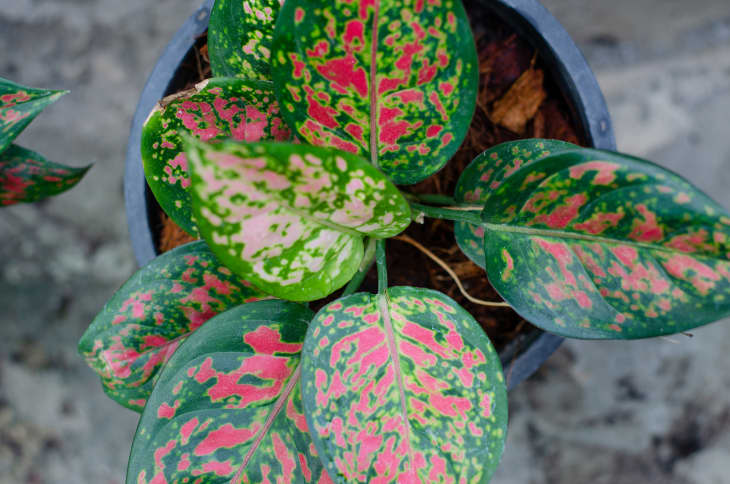Here’s the Best Way to Grow Chinese Evergreen Plants

The phrase “low-maintenance” is music to first-time plant parents’ ears. Among all the houseplants out there, it can be difficult choosing one that works in your home and with your lifestyle. Luckily, the Chinese evergreen is practically indestructible and perfect for new plant owners.
If you’ve been loyal to faux houseplants in fear of hurting the real deal, a Chinese evergreen—also called aglaonema—is worthy of consideration to help you warm up to plant parenthood. A lack of natural light won’t bring this plant down. If you forget to water it for a week, it’ll snap right back, and even windowless rooms are no match for the Chinese evergreen.
So before you start randomly filling your online cart with plants, read on about the Chinese evergreen, how to best care for them, and why they make such good plants for newbies.
About the Chinese evergreen plant
Chinese evergreen plants, also known by their genus, Aglaonema, hail from the shaded floors of Southeast Asian tropical forests. There are over 20 known species, which vary in their leaf patterns and colors. Cultivars are available with streaks and speckles of white, yellow, or even pink and red.
The ASPCA considers Chinese evergreen plants toxic to dogs and cats.
What kind of light and climate does a Chinese evergreen need?
These plants are one of the few that won’t simply tolerate low lighting but can actually do well in it. Many people like Chinese evergreens for office plants and rooms without windows because they can grow from just being exposed to artificial light. They can also handle bright indirect sunlight, but be conscious of direct sun as it can burn the leaves.
In terms of soil, Chinese evergreens have been known to do well in both peat-based potting soil and soil with perlite. But because it’s a hardy plant, most indoor potting soil mixes will do just fine.
It’s best to keep these plants between 65 and 80 degrees Fahrenheit. While sweltering heat doesn’t mix well with Chinese evergreens, it’s cold, drafty rooms that you should be more careful of. These plants thrive in warmer temperatures with a bit of humidity as opposed to super chilly and dry conditions.
How do I repot a Chinese evergreen?
For repotting Chinese evergreen, follow these steps, but just make sure you’ve got plenty of newspaper or a drop cloth to catch all the dirt!
- Select a pot that’s larger than its current home (typically three to four inches larger).
- Get your planter ready by filling it a quarter of the way with soil.
- Gently dig around your Chinese evergreen with a shovel to loosen the soil and its roots.
- Carefully lay the planter on its side and wriggle the plant out of the pot. It’s okay if a few leaves are lost in the process.
- Unlike many other plants, Chinese evergreens like being a bit root-bound. You can break up the roots every so slightly if they’re looking especially constricted and tangled, but for the most part you can leave ’em as is!
- Place your plant into its new home and fill it in with soil.
- Allow it to adjust to the pot and give it water and, if you’d like, a bit of liquid fertilizer.
How should I water a Chinese evergreen?
Chinese evergreens like lightly moist soil, but you should wait for the top two inches or so to dry out before watering again. Soil that drains well is essential—because of Chinese evergreens’ penchant for bound roots, it increases the chance of root rot and for water to sit stagnant in its pot.
Should I clean the plant’s leaves?
Occasional cleaning will contribute to a healthy plant. You can use a soft sponge or cloth to remove dust and dirt; simply lift each leaf and wipe all of its surfaces. Because Chinese evergreens fare well in humidity, a light misting never hurts either, but it’s definitely not a requirement.
What should I do if the leaves are turning yellow or the plant seems to be dying?
If the plant was overwatered, this could be the reason behind yellowing and wilting leaves. Refrain from watering your Chinese evergreen until the soil fully dries out, so you don’t exacerbate the problem. You can give it a little extra time in the sun to help evaporate excess water too.
Then, moving forward, pay attention to your watering schedule and know it’s okay if your plant gets a little bit drier between waterings. Chinese evergreens should usually bounce back from an accidental overwatering, but if the plant continues to look yellow and droopy, it most likely has root rot, and it’s worth repotting to try and save it.
How do I propagate a Chinese evergreen?
Propagating these plants is fairly simple, and they don’t have a tough time sprouting roots. The following steps will help you get started:
- Using a pair of scissors or a knife, cut off a few six-inch long stems.
- Collect your cuttings, then place them in cups of water on a window sill where they can get indirect sunlight.
- Once roots begin growing, you can remove the stems and place them into pots of soil. Many people say, too, that you can transfer Chinese evergreen cuttings directly to soil because of their ability to easily grow roots, which is always an option if you’re short on time or patience.